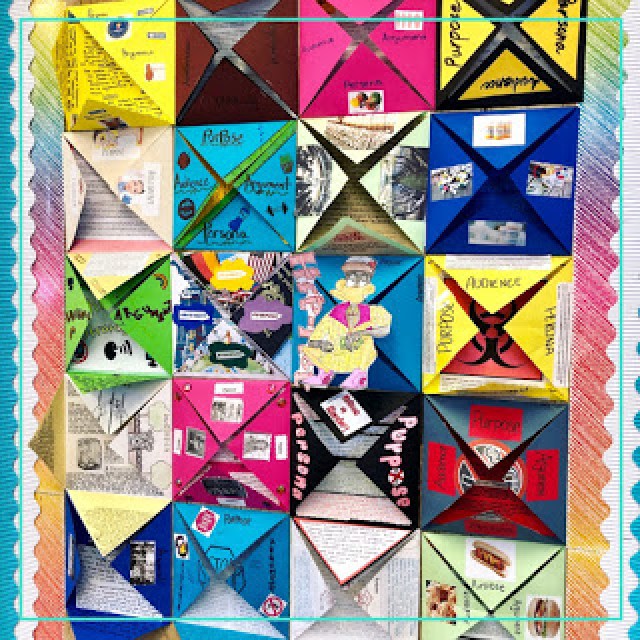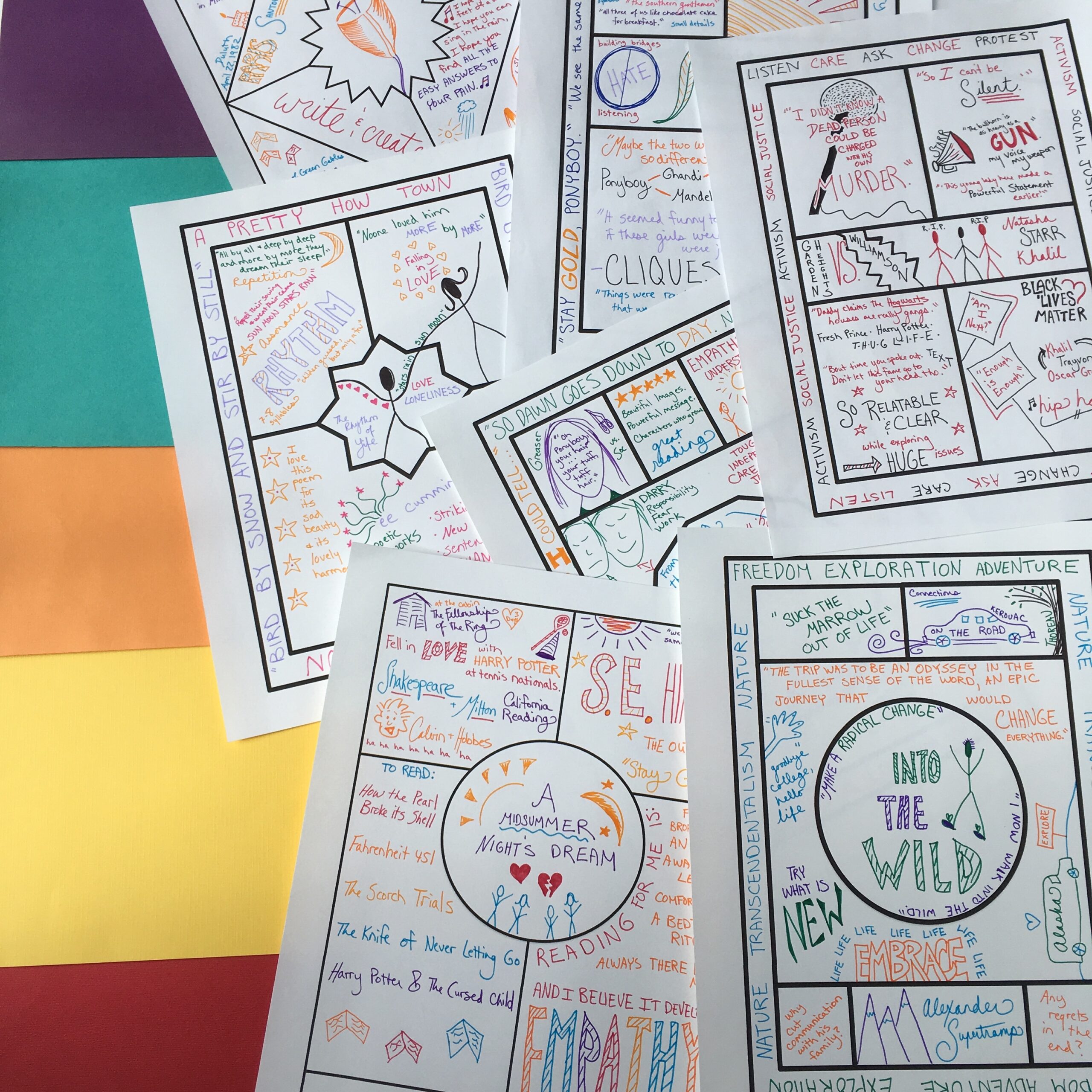
Today’s episode is brought to you by my new free mini-course, 5 Days to Build a Better Reading Program. If you’re wishing to try choice reading for the first time, or struggling to get your program going, this short e-course is for you. If you can commit ten minutes a day for one week, you’ll soon have students coming into class asking to read, arguing over your most popular titles, and telling you they’ve started to enjoy reading for the first time in their lives. I know from experience that choice reading can be one of the most rewarding parts of your career as a teacher, so I really hope you’ll sign up at the end of this post for this action-packed e-mail course.

If you’re looking for some fresh creative strategies for your classroom, this episode is definitely for you. You can listen below, or on iTunes, Blubrry, or Stitcher. Or read on for the written highlights.
Sticky Notes Literary Analysis
“I don’t know what it is about the sticky note, but kids love them. You give them a sticky note, and it’s instant engagement.” -C
The sticky notes literary analysis project is a great way to help students develop their literary analysis skills with a more kinesthetic and colorful approach than the run of the mill outline. Christina uses it at the beginning of the year with her short story unit, though you could also use it with any novel. She likes to display hers during back-to-school night as they look great on the wall.
Her students begin with a piece of paper with three squares that are the size of a sticky note on it. Then she gives them different colored sticky notes. They’re immediately intrigued.
Students search for three literary elements in their short story. They place a sticky note on their paper for each one they find. On the front of the sticky, they label the element and draw a picture of how it is represented in the story. Beneath the sticky note they write a quotation that shows the element from the story and cite it. Finally, underneath they’ll explain how that quotation proves that the literary element is in the story.
This hands-on method is great prep for writing a paragraph. Plus, the images really show their different ways of interpreting the story. Seeing the picture seems to help them find the quotation. Once they’ve found three literary elements, drawn them, found quotations for them, and analyzed how the quotations represent the elements, they’ve done some solid writing practice without dealing with the usual challenges of writer’s block.
Mock Trials
“Towards the end of the year, you are just over grading essays. You’re just trying to find diffferent ways of assessing learning that’s not an essay.” -C
Mock trials are such an amazing way to bring students into the world of the text. Christina used one with her students when they read The Stranger. Her goal was to bring an authentic engagement with the text through a medium that was different than an essay. She was able to accomplish that goal, in spades, in just a week’s worth of classes.
She began by explaining the concept of the trial to students, telling them the goal was to engage on a deeper and more personal level with the book. Then she assigned students roles – defendants, prosecution, prosecution’s witnesses, defense, friendly witnesses, jury. In retrospect, Christina feels it would have been better to let students sign up for roles or apply, as certain roles (like the lawyers) really call out for extra enthusiasm and work ethic.
Each type of role had a different job to do.
Defense and Prosecution attorneys: need to come up with their main points and think about how to examine the witnesses to prove their points. Then they need to meet with their witnesses to make sure they are ready to answer in helpful ways that are true to the text.
Characters (defense and prosecution witnesses): need to learn everything they can about their characters and understand the book as much as they can. They will practice their responses to their team’s questions, but will have to be ready for cross-examination.
Jury: need to learn everything about everything. Their role will be to chat, via a Google doc, during the two days of trial proceedings and determine where the slip-ups and mistakes in textual analysis appear. They will decide which side was the most accurate in their arguments and evidence.
Once students were prepared, the big day came! Christina was the judge, wearing her graduation robe and carrying a toy gavel. Each student had a laminated sign labeled with their role, and several dressed in costume. The jury listened and debated as the witnesses were called, examined, and cross-examined.
The trial was a big success, with many students listing it as one of their favorite experiences from the course when the term came to an end.

PAPA Squares
“All of the strategies that we use to teach the English Learners, those also help all of the English only learners as well.” – C
PAPA squares are a rhetorical analysis strategy, similar to the SOAPSTONE method, but a little less complicated.
PAPA stands for:
Purpose
Argument
Persona
Audience
This strategy can be used with students simply by folding a piece of paper in half twice and writing down the four elements in the corners of the page, but Christina took it several steps further. (Who’s surprised?)


She introduced the PAPA method in class and asked students to apply it to the article of their choice.
Then she brought in bright pieces of 12 X 12 yardstick from Amazon and asked students to begin applying the PAPA elements onto their pages. Students were to identify each element on one flap of their large papers, then find a quotation that would represent that element, then explain it. On the back, they wrote a four-sentence rhetorical precis based on what they had discovered. Finally, they decorated their papers to show the overall themes and ideas of their chosen articles.
As with the sticky notes literary analysis, this project is a deep dive into critical thinking and strong writing, but it combines the verbal and the visual to help engage all students. This combination is a strong strategy for engaging English learners, but it is also helpful for every learner.
In the end, Christina felt there was actually more work in this project than in a standard literary essay, and it hits all the same standards. The difference is, students like it more!

“Here she is, she’s got her palms of both of her hands bright blue. And it’s one of those moments where you’re just like this is learning, this is creating, they are demonstrating that they understand and they are having fun and they’re engaged. It was a really rewarding moment.” -C
This final board game project could be used for any novel. It’s a way for students to process the reading, building their depth of understanding into the questions and challenges of their games.
Christina used this project for The Odyssey, with the following requirements.
The games needed to…
- Incorporate vocabulary, Godly encounters, monsters
- Be playable
- Follow the story (Odysseus had to get back home)
- Have character pieces
“This lesson came from my inbox.” – C
Christina’s school focuses on college and career readiness. She feels strongly that though college might not be for everyone, it’s important to give students the tools to be successful communicators regardless.
This short lesson at the beginning of the year saves headaches all year long, gives students important communication skills, and doubles as a way to break the ice and get to know each other.
She begins by briefly letting her students know what e-mail etiquette is. Then she asks them questions about what you should and shouldn’t do in e-mails and they all have fun with the subject as they brainstorm answers.
For example, she might ask, “What do you NOT do when e-mailing a teacher?” While they’re a bit shy and timid at first, the conversation soon becomes hilarious
Or she might ask, “What SHOULD you do?” It’s always clear, they know! They just fall into the trap of rushing.
Once they’ve done some brainstorming together, Christina briefly goes over the dos and don’ts, how to structure an e-mail, what a salutation is, etc.
Then comes the big finale. She displays sample emails on the projector, almost straight from her inbox, and asks “What’s wrong?”
The kids inevitably and immediately see what to change. They talk about improving the tone, adding punctuation, etc.
Teaching e-mail etiquette doesn’t need to take long, because kids already know most of the main points. They just need some clear reminders and a little humor. To assess their takeaways, Christina has the kids e-mail her or write an e-mail in a Google Doc, introducing themselves with a personal statement in the e-mail format. What a great way to get to know each other at the start of the year!
Whew! That’s the end of our whirlwind creative tour with Christina. Isn’t she fabulous? Find out more about her and her work below!

Connect with Christina from The Daring English Teacher

“I teach at a semi-rural high school in the outskirts of Los Angeles. Mainly, I teach freshmen and sophomores; although the freshmen curriculum is my favorite. Most of my students are high-risk English language learners, and many of them come from poverty. Many of my students deal with situations that no teenager should ever face. They teach me new things everyday, and I try to do the same for them.” -Christina
Check out her Website
Enjoy her Instagram



























One Comment
Wow, cool post. I’d like to write like this too – taking time and real hard work to make a great article… Happy New Year Wishes 2021